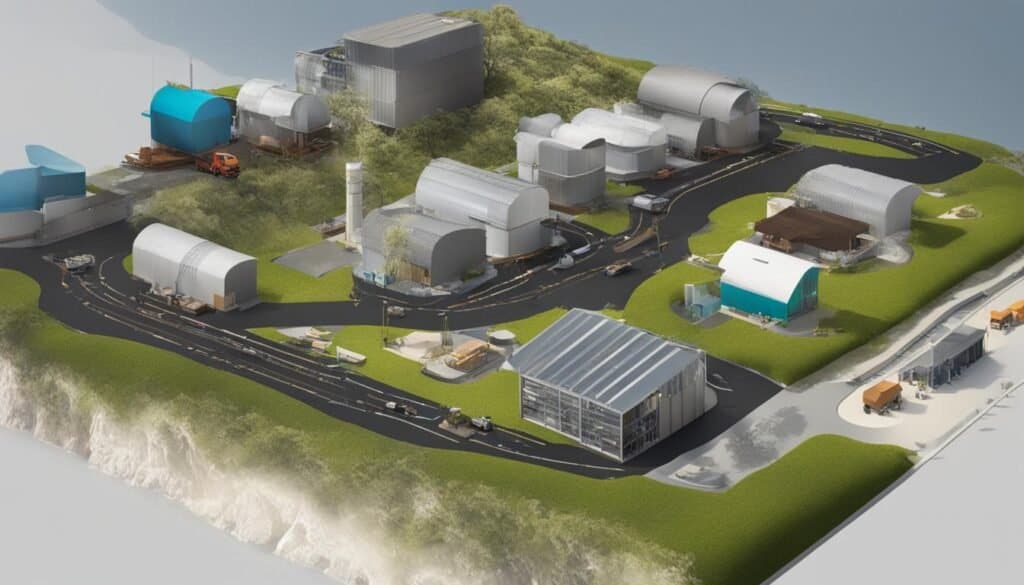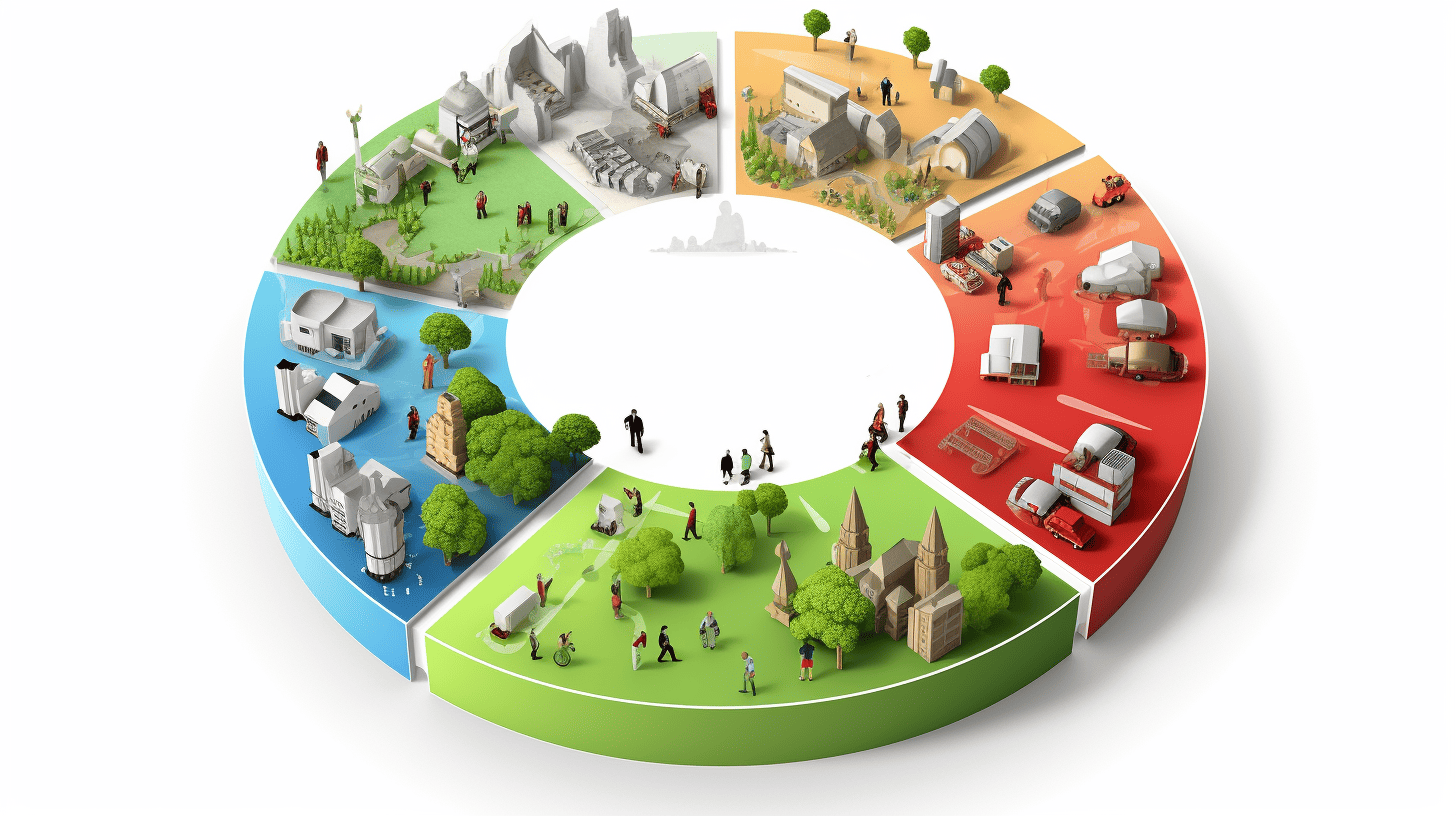As a professional copywriting journalist, I’m excited to share my insights on lifecycle assessment (LCA) – a crucial tool in evaluating the sustainability of products, services, and processes. By delving into the nitty-gritty of LCA, we can better understand product lifecycle analysis and the environmental impact analysis associated with everything we create and use.
This knowledge empowers us to make better choices for our planet and aligns with the UN’s Sustainable Development Goals. So, let’s dive into sustainability evaluation and learn how to address climate change through product and process efficiency!
Key Takeaways
- Life cycle assessment (LCA) is an essential tool for evaluating the environmental impact of products and processes.
- LCA provides a holistic view of a product’s life cycle, from raw material extraction to end-of-life disposal.
- The four main components of LCA are goal and scope definition, life cycle inventory (LCI), life cycle impact assessment (LCIA), and interpretation.
- International standards such as ISO 14040 series play a significant role in guiding LCA studies and maintaining consistency.
- Through LCA, manufacturers and businesses can identify eco-friendly practices and integrate sustainability strategies to minimize their environmental footprint.
Understanding the Basics of Life Cycle Assessment
Life Cycle Assessment (LCA) is a foundational approach used to determine the environmental impacts of products or systems over their complete life cycle. Widely recognized for its scientific rigor and comprehensive scope, the LCA methodology encompasses multiple stages, including raw material extraction, production, transportation, usage, and disposal, ensuring no aspect of the product’s existence is overlooked.
This systematic approach allows for accurately calculating environmental effects, such as greenhouse gas emissions, energy consumption, and more.
Environmental auditing plays a significant role in the LCA process, as it helps businesses identify potential areas for improvement and highlight successful strategies. Environmental auditing aims to measure and analyze performance indicators, such as the carbon footprint of a product or process, enabling organizations to make informed decisions about sustainability.
Ecochain emphasizes the importance of defining the goal and scope in the first phase of LCA, as this sets the foundation for the entire assessment process.
An essential aspect of LCA is incorporating inventory analysis, which details the inputs and outputs throughout the product’s life cycle. This data-driven approach helps inform the overall assessment of a product or system’s environmental impacts, allowing for greater accuracy and transparency in the evaluation process.
While LCA is employed in various industries, its application is especially crucial in assessing contributions to global warming. Carbon footprint calculation is a significant component of these evaluations, which quantifies greenhouse gas emissions and their potential impact on climate change.
Life Cycle Assessment is a systematic and comprehensive approach to evaluating the environmental impacts of products throughout their entire life cycle, including raw material extraction, production, transportation, usage, and disposal.
Let’s take a closer look at key stages of LCA about environmental effects:
- Raw Material Extraction: Provides insight into the environmental impacts of natural resource extraction, such as deforestation and habitat loss.
- Production: Evaluate manufacturing processes’ environmental footprint, including energy consumption and waste generation.
- Transportation: Analyzes the emissions and resource consumption associated with the distribution of products from the production facility to the point of sale or use.
- Usage: Examines the environmental impacts during the product’s operational life, such as energy and water use and waste generation.
- Disposal: Assesses the environmental consequences of end-of-life scenarios, including recycling, waste disposal, and degradation of materials.
By taking a holistic view of a product or system’s life cycle, LCA can help us better understand the environmental implications of our choices and inform more sustainable decision-making.
| Stage | Environmental Impact | Examples of Key Factors |
|---|---|---|
| Raw Material Extraction | Resource depletion, habitat loss | Deforestation, mining, water use change |
| Production | Energy consumption, waste generation | Input materials, manufacturing processes, waste management |
| Transportation | Emissions, resource consumption | Fuel type, transportation distance, vehicle efficiency |
| Usage | Resource use, waste generation | Energy and water consumption, maintenance requirements, waste disposal |
| Disposal | End-of-life environmental consequences | Recycling, landfill emissions, incineration |
Identifying the Components of LCA: Goal and Scope
When embarking on a Life Cycle Assessment (LCA), it is imperative to identify the purpose and boundaries of the study. This allows for a more targeted and coherent evaluation of the environmental impact of products throughout their life cycle. In this section, we will discuss the critical components of LCA, including the goal and scope of the study, as well as the importance of defining system boundaries.
“The goal of LCA is to address the environmental aspects and potential impacts associated with a product throughout its life cycle within a targeted approach.”
The Importance of a Clear Objective in LCA
Establishing a clear objective is pivotal in any LCA, as it guides the study’s goal and scope. This includes the functional unit related to the product’s primary function and the system boundaries. A well-defined goal allows for a structured and targeted assessment, ensuring efficient resource allocation and more accurate sustainability evaluation.
Furthermore, having a clear objective enables better environmental management as it helps identify areas for improvement. These insights can then be utilized for decision-making processes such as product design and procurement and sustainability reporting.
Defining the Boundaries: System Scope Examination
System boundaries are a crucial component of an LCA, as they delineate the extent of analysis. In other words, they outline what parts of the product’s life cycle are to be included – and excluded – in the study. Incorporating all stages of a product’s life, from material extraction and production to transportation, usage, and end-of-life scenarios, allows for a comprehensive understanding and evaluation of all associated environmental impacts.
- Material extraction and raw material processing
- Production and manufacturing
- Transportation and distribution
- Usage and maintenance
- End-of-life treatment and disposal
| Phase of the Life Cycle | Examples of Environmental Impacts |
|---|---|
| Material extraction | Depletion of natural resources, habitat destruction |
| Production | Energy consumption, air and water pollution |
| Transportation | Greenhouse gas emissions, noise pollution |
| Usage | Resource consumption, waste generation |
| End-of-life | Waste management, recycling, landfill emissions |
Defining these system boundaries is vital for obtaining an accurate and informative environmental impact scorecard, which can be used for internal decision-making and external sustainability reporting purposes. You can create a robust and reliable LCA that facilitates more sustainable product development and business practices by being thorough and deliberate in setting the goal and scope.
Life Cycle Inventory (LCI): Mapping the Inputs and Outputs

The Life Cycle Inventory (LCI) is a crucial phase in a Life Cycle Assessment, as it breaks down the product system’s inputs and outputs, including resource extraction and substance emissions. LCI helps evaluate a product’s environmental footprint throughout its entire life cycle, from the cradle to the gate.
LCI involves quantifying the inputs and outputs of a product system, providing a comprehensive view of its environmental impacts.
Understanding the LCI phase requires a look into three major components:
- Collection of Data
- Eco-efficiency Evaluation
- Material Flow Analysis
Collection of Data
Collecting accurate and exhaustive data is essential for conducting an effective LCI. Databases like ecoinvent provide a wealth of information, including data on resource extraction, energy consumption, and emissions for various products and processes. This data is critical for comparing and analyzing the environmental footprints of different products.
Eco-efficiency Evaluation
Evaluating the eco-efficiency of a product involves analyzing the ratio of its environmental performance to its economic value. An eco-efficient product will have a lower environmental footprint and deliver higher economic benefits over its life cycle. Assessing eco-efficiency in the LCI phase helps determine the sustainability of product choices and identifies improvement areas.
Material Flow Analysis
Material Flow Analysis (MFA) tracks and quantifies the flow of materials and substances in a product system. By examining a system’s inputs and outputs, MFA identifies resource use, tracks emissions and wastes, and uncovers potential inefficiencies. This information can help inform product design, manufacturing processes, and end-of-life management to minimize environmental impacts.
In conclusion, the Life Cycle Inventory is a critical aspect of LCA that provides the foundation for understanding the environmental impacts of a product throughout its life cycle. By collecting comprehensive data, evaluating eco-efficiency, and conducting material flow analysis, LCI arms decision-makers with the information they need to develop more sustainable products and processes.
Interpreting Impact Categories in Life Cycle Impact Assessment (LCIA)
Life Cycle Impact Assessment (LCIA) is an essential phase in measuring environmental impacts associated with a product’s life cycle, focusing on multiple influential factors.
Greenhouse Gas Emissions and Their Measurement
Greenhouse gas emissions contribute significantly to climate change, making their measurement a crucial aspect of LCIA. These emissions are usually quantified in carbon dioxide equivalents (CO2eq) to measure their global warming potential over a standardized timeframe. Addressing greenhouse gas emissions is essential for effective climate change mitigation and reducing the environmental impact of a product.
Addressing the Acidification and Eutrophication Potentials
Soil and water bodies are significantly impacted by acidification and eutrophication potentials, which degrade ecosystem health. In LCIA, substances contributing to these impacts are generally converted into sulfur dioxide equivalents (SO2eq) and phosphate equivalents (PO4eq) to facilitate a comparative understanding of their environmental consequences.
- Acidification Potential (AP): This impact category measures the potential of emissions to cause acid rain and affect soil quality. Higher values indicate a greater risk of acidification.
- Eutrophication Potential (EP): EP deals with the potential for nutrient enrichment in water bodies, leading to ecosystem degradation. Higher values for eutrophication potential mean a higher risk of nutrient enrichment.
Developing effective pollution prevention strategies is vital to minimize acidification, eutrophication potentials, and any subsequent risk of ecosystem degradation.
Considering Ozone Depletion and Global Warming Potential
LCIA also considers various substances and emissions’ ozone depletion potential (ODP) and global warming potential (GWP). Both potentials play a significant role in assessing the environmental risk of products and processes.
- Ozone depletion potential (ODP): ODP measures the relative potential of substances to degrade atmospheric ozone compared to a reference substance (chlorofluorocarbon-11). Different emissions are given values depending on their ODP; higher values indicate a greater potential for ozone depletion.
- Global warming potential (GWP): GWP evaluates the relative radiative forcing of greenhouse gases over a certain period. It is expressed in CO2eq to compare the warming effects of various greenhouse gases. Higher GWP values indicate that a substance has a greater potential to contribute to global warming.
By considering ODP and GWP in the LCIA, decision-makers can better understand the trade-offs between different emissions and their potential environmental impacts, ultimately informing the development of more sustainable solutions.
Life Cycle Interpretation: Making Informed Decisions

The process of life cycle interpretation is crucial to deriving meaningful insights from LCA results and aiding stakeholders and decision-makers in implementing effective sustainability practices. This phase encourages better environmental performance and facilitates the development and enhancement of product stewardship programs. By identifying areas of improvement, companies can make informed decisions that align with their long-term environmental objectives.
- Identifying significant environmental issues linked to the product or system being assessed.
- Determining the robustness and reliability of the LCA data and results.
- Comparing alternative scenarios or options to provide insights on potential improvements.
- Communicating the findings and recommendations to relevant stakeholders.
Effective communication of LCA results to stakeholders is paramount in ensuring the success of any product stewardship program. This enables meaningful discussion and collaboration on matters of sustainability and environmental performance.
“Life cycle interpretation is the key to unlocking the true value of Life Cycle Assessment, allowing businesses to make informed decisions that drive sustainable practices throughout their operations.”
Some examples of how life cycle interpretation can influence sustainability-oriented decisions include:
- They are optimizing manufacturing processes for reduced energy consumption and emissions.
- Selecting eco-friendly materials or suppliers to minimize the environmental impact of products throughout their life cycle.
- Implementing waste reduction and recycling initiatives, encouraging a circular economy approach.
- Improving consumer-facing messaging on a product’s environmental benefits fosters customer engagement and loyalty.
The following table showcases a brief comparison of two hypothetical products based on their LCA results and highlights the importance of life cycle interpretation in making informed decisions on product design, manufacturing, and end-of-life management.
| Aspect | Product A | Product B |
|---|---|---|
| Global Warming Potential | 1,200 kg CO2 eq. | 900 kg CO2 eq. |
| Energy Consumption | 10,000 MJ | 8,000 MJ |
| Water Usage | 5,000 L | 4,000 L |
| Recyclability | 50% | 80% |
By effectively interpreting LCA results and communicating these findings, organizations can significantly advance their sustainability objectives and support a greener future for all.
ISO 14040 Standards and the Framework of LCA

The International Organization for Standardization has established a set of comprehensive guidelines in the form of the ISO 14040 series, which serves as a solid foundation for conducting Life Cycle Assessments (LCAs). The primary role of these guidelines is to offer a structured and systematic approach to assessing the environmental impacts of products, services, and processes, allowing stakeholders to make informed decisions and improve sustainability.
These guidelines promote consistency, credibility, and transparency throughout the LCA process, ensuring stakeholders can rely on the results to shape their environmental management policies. By adhering to the ISO 14040 series, professionals can tackle complex environmental challenges head-on using a unified and rigorous life cycle assessment framework.
“ISO 14040…provides international standards to ensure consistency, credibility and transparency in the assessment process.”
The Role of International Standards in LCA
International standards, such as the ISO 14040 series, aid organizations striving to meet sustainability standards by providing a consistent methodology to follow. When organizations and businesses adhere to these guidelines, they benefit from a reliable and transparent evaluation process aligned with the global need for better environmental management systems.
For instance, the ISO 14040 standards offer:
- A systematic approach to accurately evaluate the entire life cycle of a product or service
- A way to identify and quantify environmental hotspots where improvements can be made
- A tool to support green procurement practices and eco-design principles
- A means of measuring and reporting an organization’s progress toward sustainability goals
| ISO 14040 Series Standards | Primary Focus |
|---|---|
| ISO 14040 | Principles and framework for life cycle assessment |
| ISO 14044 | Requirements and guidelines for LCA, including goal and scope definition, inventory analysis, impact assessment, and interpretation |
| ISO 14046 | Environmental management – Water footprint – Principles, requirements and guidelines |
| ISO 14071 | Guidance on extending the LCA methodology to support critical review and stakeholder involvement processes |
As sustainability becomes an increasingly important concern for both businesses and consumers, adherence to ISO 14040 standards and a strategic implementation of life cycle assessment framework will ultimately help organizations measure, report, and make informed decisions to preserve and protect the environment we depend on.
Applying LCA to Achieve Sustainable Manufacturing Practices
In today’s highly competitive and environmentally conscious business landscape, adopting sustainable manufacturing practices is more important than ever. Life Cycle Assessment (LCA) is a powerful tool that helps organizations identify opportunities for improvement and implement efficient and environmentally responsible processes. By integrating eco-design principles, these practices not only minimize the environmental impact but also contribute to a company’s growth and reputation.
The GSA Sustainable Facilities Tool suggests that when defining LCA boundaries and scope, it’s important to decide which environmental impacts to focus on and ensure the availability and reliability of the data needed to quantify these impacts.
Effective environmental management requires a comprehensive understanding and evaluation of resource lifecycles associated with manufacturing processes. Through implementing LCA, businesses can analyze their products and systems from cradle to grave. This allows them to pinpoint areas of concern, enabling the efficient allocation of resources for the development of sustainable production techniques.
With the help of LCA, manufacturers can better align their operations with sustainability goals. This can benefit the organization in terms of cost reduction, eco-friendliness, and compliance with environmental regulations. In conclusion, applying LCA in manufacturing practices establishes a robust foundation for sustainable decision-making and drives businesses toward a more responsible and prosperous future.
FAQ on Product Life Cycle
Q: What is the environmental impact of using Life Cycle Assessment (LCA)?
A: Life Cycle Assessment (LCA) aims to reduce the environmental impact throughout a product’s life cycle. By conducting a life cycle inventory analysis, LCA can identify and quantify resource use and emissions to provide strategies to improve the environmental performance of a product from inception to end of life.
Q: Can LCA tools enhance the concept of sustainability?
A: Absolutely. LCA tools allow for the assessment of various environmental, social, and economic impacts throughout a product’s life cycle. This holistic view helps in making more sustainable choices, relevant to new life cycle developments or changes, based on an overall perspective rather than a single phase.
Q: How could I assess various products using LCA standards?
A: The assessment of products using LCA standards is done by following certain steps. It starts with the definition of the scope of the LCA, then proceeds with a life cycle inventory analysis. The results of this analysis are then interpreted to help make more sustainable decisions. There’s a wide range of LCA software available that can assist with this process.
Q: How can the use of LCA improve the environmental performance of a product?
A: LCA helps to identify the environmental hotspots during the life cycle stages of a product. Analysing these stages allows for the creation of strategies to reduce negative impacts, thereby improving the environmental performance. The LCA approach provides guidance about where to focus efforts for the greatest effect.
Q: Can you describe the standard phases of an LCA?
A: The standard phases of an LCA include the definition of the purpose and scope of the LCA, the life cycle inventory analysis, the life cycle impact assessment, and interpretation. From inception through disposal, these phases cover impacts throughout a product’s life cycle.
Q: What’s the difference between attributional LCA and other types of LCAs?
A: Attributional LCA is one type of LCA that focuses on the environmental impacts directly attributable to the production and use of a product. It differs from consequential LCA, which tries to understand the environmental consequences of a decision or a proposed change in a system under study (product system, service system).
Q: How can I make the most of LCA software for environmental assessment?
A: LCA software can provide a comprehensive environmental assessment covering economic input-output life cycle assessment and other environmental management standards. By combining your product data with comprehensive databases, LCA software allows you to visualize and understand the environmental impacts of your product over its complete life cycle.
Q: What does “end of life” mean in the context of an LCA approach?
A: In the context of an LCA approach, “end of life” refers to the final stage in a product’s life cycle. This could range from disposal to recycle or reuse. LCA aims to minimise the environmental impacts at this stage, including waste production and release of harmful substances.
Q: What are some of the assessment tools used in an LCA?
A: Some key assessment tools used in an LCA include LCA software that helps to collect, process, and analyze data, databases containing environmental impacts of materials and processes, and frameworks or standards like the ISO 14040 series that guide the LCA process.
Q: What resources are available for a beginner interested in mastering sustainability and LCA?
A: There are several resources to guide a beginner interested in mastering sustainability and LCA. These include educational books such as “A Comprehensive Beginners Guide to Life Cycle Assessment”, online courses, workshops, and webinars by environmental organizations, and software tutorials specifically on how to conduct an LCA.





Leave a Reply